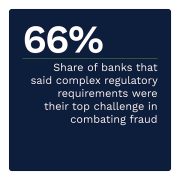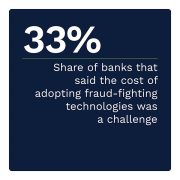Identity fraud has been growing in recent years and had a notable increase in 2021. Identity theft alone accounted for $56 billion in losses that year, up 79% from 2020, and the number of these thefts reported to the Federal Trade Commission (FTC) grew 22% since 2020. Consumers logged nearly 1.7 million reports of identity theft with the FTC, making it the most frequent complaint, comprising 29% of the total reports received.
 Businesses are using a variety of different fraud prevention solutions to verify customers and limit the amount of friction and other obstacles that can drive consumers away. Implementing solutions that leverage artificial intelligence (AI) is one of the top priorities for financial decision makers, as these tools can verify customers and transactions behind the scenes with a minimum of customer input and friction.
Businesses are using a variety of different fraud prevention solutions to verify customers and limit the amount of friction and other obstacles that can drive consumers away. Implementing solutions that leverage artificial intelligence (AI) is one of the top priorities for financial decision makers, as these tools can verify customers and transactions behind the scenes with a minimum of customer input and friction.
This edition of the “Digital Fraud Tracker®” examines the varying types of identity fraud facing corporates today, and the variety of different fraud prevention solutions to verify customers and limit customer friction.
Around the Digital Fraud Space
The notion of fraudsters looking to steal identities to commit their crimes is rapidly becoming dated. Instead, many cybercriminals are fabricating synthetic identities for this purpose. A recent study found that losses due to synthetic identity fraud could double from this year’s $2.5 billion to nearly $5 billion over the next two years.
 eCommerce fraud has grown more common over the course of the pandemic, commensurate with an increase in eCommerce traffic. One of the biggest drivers of this increase is identity theft, with credentials often obtained through phishing and data breaches. More than 1.1 billion personal records were leaked through data breaches last year, resulting in billions of dollars in losses for eCommerce merchants through chargebacks, lost revenue and damaged customer relationships.
eCommerce fraud has grown more common over the course of the pandemic, commensurate with an increase in eCommerce traffic. One of the biggest drivers of this increase is identity theft, with credentials often obtained through phishing and data breaches. More than 1.1 billion personal records were leaked through data breaches last year, resulting in billions of dollars in losses for eCommerce merchants through chargebacks, lost revenue and damaged customer relationships.
For more on these and other stories, visit the Tracker’s News and Trends section.
Learn From an Insider How Data Is Key to Preventing Identity Fraud
Bad actors are growing more sophisticated in their identity fraud techniques, leveraging advanced AI technology to stage attacks on an industrial scale. Preventing identity fraud comes down to effective data utilization.
To get the Insider POV, we spoke with Lien Nguyen, senior vice president of fraud prevention at Bank of the West, to learn more about the top identity fraud threats and how to stop them.
 PYMNTS Intelligence: Leveraging Technology to Combat Identity Fraud
PYMNTS Intelligence: Leveraging Technology to Combat Identity Fraud
A recent study found that businesses lost $52 billion to identity fraud in 2021, a shocking 79% increase year over year. The current rate of identity fraud losses is untenable for businesses, especially if this skyrocketing growth continues on its current trajectory.
This month, PYMNTS explores the various types of identity fraud leveraged by bad actors and how businesses can protect themselves by implementing advanced AI systems.
About the Tracker
The “Digital Fraud Tracker®”, a PYMNTS and DataVisor collaboration, examines the varying types of identity fraud facing corporates today, and the variety of different fraud prevention solutions to verify customers and limit customer friction.